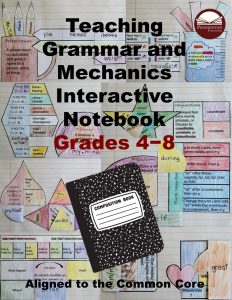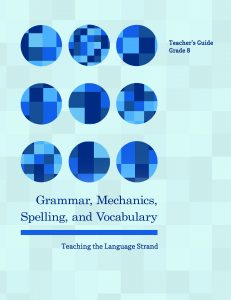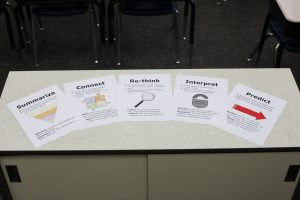Interactive notebooks (INBs) have become increasingly popular in all subject areas: reading, science, math, history/social studies, language arts, art, and foreign language study. Homeschooling advocates have long favored learning portfolios and have been particularly engaged in the INB movement. Additionally, the exponential influence and use of Pinterest in education has propelled publication of many INBs on sites such as Teachers Pay Teachers. Whether you are an INB inquirer or practitioner, it’s it’s useful to analyze the pros and cons as to whether INBs should be used in your home or classroom. To provide fodder for a balanced discussion, I have written 10 Reasons Not to Use Interactive Notebooks.
My own experience with INBs? I used INBs in middle school ELA for years before developing and using a more traditional grammar, usage, mechanics, spelling and vocabulary program (See product promotion at end of article). I also taught with the Teachers’ Curriculum Institute (TCI) Interactive Student Notebooks in their History Alive! series. Moreover, I just completed a Teaching Grammar and Mechanics Interactive Notebook series. Click HERE to check it out. If you do, I’m sure you will see why this classroom-tested INB is the best one available for your students.
Although teachers have valid reasons not to use INBs (1. Excessive class time 2. Too much prep 3. Too much correcting 4. Too messy 5. Not enough rigor and little critical thinking 6. Too teacher-centered and little focus on individual student needs 7. Not assessment-based instruction 8. Too supplemental and reductive (little focus on reading and writing) 9. Not real-world, career-based instruction 10. Some students dislike INBs), many teachers do see value in using interactive notebooks. To get past my own biases, I studied dozens of INBs and INB templates (most INBs use 3D graphic organizers such as pop-outs, flip pages, and foldables) in quite a few subject areas. I examined individual lessons found on Pinterest, teacher blogs, and Facebook. I also looked at partial and full-year published INB programs. In fact, I purchased the two best-selling INB programs: Erin Cobb’s Interactive Grammar Notebook for Common Core Grades 4-8 (over 30,000 sold with over 6,000 product reviews) and Nicole Shelby’s grades 2-5 Interactive Language Notebooks (14,531 product reviews at the time of this writing). Of course, it’s always good for writers to check out the best of the competition when developing their own alternative products 🙂 Both are great programs and certainly worth every penny.
So, here’s the list of reasons to consider using INBs. But don’t take my word on it, check out the teacher comments as well.
10 Reasons to Use Interactive Notebooks
1. Interactive notebooks personalize learning. Teachers know that relevance matters. When students perceive content and skills as important to their “now and then” (immediate and future needs), they are more willing and capable of engaging in learning new content and skills. Education is a two-way process. Certainly students need input, but they also filter that input through prior knowledge and experiences and make personal meaning out of that input. INBs provide students with the connections they need between the outer world of ideas and their inner worlds of how they make sense of those ideas. When students own their interactive notebook lessons with learning goals, “I Can” statements, comments, opinions, and questions, they learn content and skills at a deeper level and retain more knowledge.
2. Interactive notebooks balance input, processing, and output. Teachers know the importance of direct instruction. Whether teachers initiate the learning as in a traditional classroom, or guide the learning as in a flipped classroom, we do serve as the “keepers of the keys” to learning. We know the Standards; we know what students know and don’t yet know; we know how students learn best. However, we don’t always provide the time or teach the process of learning. INBs provide the mechanisms teachers and students need to process new content and skills. To borrow Stephen Krashen’s expression: comprehensible input. After all, it’s all about learning, not teaching. When students add to or highlight key ideas in lecture notes, take marginal annotations on short INB articles, and summarize learning in 3D graphic organizers, they are processing information. We all know how much learning is lost when it is not immediately reinforced. Practice using the content and skills in the INB immediately after the lecture provides that reinforcement. The INBs stop the forgetting cycle and imprint learning into long-term memories.
3. Interactive notebooks help students learn and study at the same time. One real benefit of the INB is the focus on “killing two birds with one stone.” A key feature of INBs is test preparation. When a student cuts out a matchbook style foldable of M. A.I.N. (the main causes of World War I–Militarism, Alliances, Imperialism, and Nationalism), they are not only synthesizing information from lecture notes; they are also creating a study guide or essay pre-write for the upcoming unit test. Many teachers permit students to use their INBs on quizzes and tests to motivate proper notebook preparation and completion. Other teachers value the INB as a learning end in of itself as a performance-based assessment.
4. Interactive notebooks are a cross-curricular approach to instruction and learning. More and more schools have adopted INBs as the learning approach in all content-based and skill-based subject areas or classes: reading, science, math, history/social studies, language arts, art, and foreign language study. The authors of the Common Core emphasize the important of cross-curricular, interdependent instruction in the College and Career Readiness and Anchor Standards. Secondary schools in particular have embraced schoolwide AVID (Advancement Via Individual Determination) strategies such as Cornell Notes in their INB classrooms. INBs truly can serve the purpose of providing a similar user-friendly language of instruction, organization, and philosophy of learning. BTW, my recently completed INB provides both student and teacher lessons in Cornell Notes format.
 5. Interactive notebooks make sense of lecture and note-taking. The Common Core State Standards are indeed rigorous and require more, not less, input. The world knowledge base is compounding. Well-planned lectures still are viable and significant means of instructional delivery for both elementary and secondary classrooms. Rather than slowing the pace of instruction and causing day-dream boredom with elongated “interactive lectures,” INBs provide the interactivity within the notebooks themselves. Gone are the days of fifty minute didactic lecture-speeches with only a few question-answer interruptions. Teachers find that shorter 20 minute lectures with connected INB activities for the remaining 30 minutes get better results.
5. Interactive notebooks make sense of lecture and note-taking. The Common Core State Standards are indeed rigorous and require more, not less, input. The world knowledge base is compounding. Well-planned lectures still are viable and significant means of instructional delivery for both elementary and secondary classrooms. Rather than slowing the pace of instruction and causing day-dream boredom with elongated “interactive lectures,” INBs provide the interactivity within the notebooks themselves. Gone are the days of fifty minute didactic lecture-speeches with only a few question-answer interruptions. Teachers find that shorter 20 minute lectures with connected INB activities for the remaining 30 minutes get better results.
6. Interactive notebooks de-emphasize isolated practice. All too often in many classrooms, practice has been unrelated to instruction or student needs. INB teachers find that connected practice in the notebook serves students better than isolated drill and kill worksheets. Of course, targeted worksheets tied to an INB lecture or activity can certainly be added into the notebook itself. Glue is not for foldables alone.
7. Interactive notebooks provide “published” learning portfolios. In many respects, INBs have mimicked the writing process. Years ago, teachers began seeing the value of a step-by-step writing process in which the ultimate goal of publication for an authentic audience (not just the teacher-grader) was the end goal. Publication increases motivation and accountability, as well as the quality of work. In the case of the INB, the publication includes peer and parent review or presentation in class, parent-student-teacher-counselor conferences, and at Open House. Many teachers pass along INBs to the next grade level teacher as portfolios of student work for review or to continue the notebook. Publication provides concrete evidence of students’ learning. If they know it, they will show it becomes the mantra of an INB instructional approach.
8. Interactive notebooks teach the values of organization, neatness, and pride of work. “Since when did neatness and coloring become Standards?” complains one teacher. It’s true that some teachers go over the top in terms of time expended upon or concentration on neatness and appearance of the notebooks. Most INB teachers strike a workable balance between achievement and effort. Rafael will never produce the same level of artistic accomplishment as Janie. His lack of fine motor skills and her cool sets of high quality pastels and colored markers ensure their respective outcomes. However, it is certainly reasonable to expect Rafael to adhere to the organizational demands of the notebook and use the color coding to properly categorize the kingdoms and phyla for his science INB. Plus, his table of contents, numbered pages, and right-left orientation have to be accurate. Additionally, Janie’s INB has to have accurate content, insightful reflection, and properly annotated margin notes on her close readings and not just a Da Vinci quality INB. A little bit of peer pressure certainly does not hurt, nor does teacher affirmation of everyone showing pride of work and doing the best they can.
9. Interactive notebooks provide a classroom management system for effective learning. One of the tenets of P.B.S. (Positive Behavior Support) is that an active and productive class setting with clear behavioral and academic expectations helps behaviorally challenged students stay engaged in the learning activities. Students are far less likely to cause class disruptions when they are invested in “hands-on” doing-style learning. Additionally, “idle hands are the devil’s workshop.” Bored students create problems. The INB keeps students focused on the learning task, even when a social environment is permitted.
10. Many students love interactive notebooks. Students prefer INB over tradition instruction because the notebooks are personalized and interactive. Students enjoy the social nature of the INB process. The learn by doing philosophy has been a particularly American approach to learning ever since John Dewey advocated this practice over a century ago. Students rarely describe INB classes as “boring.” And let’s face it; almost everyone loves to color:)

Interested in checking out the author’s Teaching Grammar and Mechanics Interactive Notebook? Check it out HERE.

Grammar, Mechanics, Spelling, and Vocabulary
Grammar/Mechanics, Reading, Spelling/Vocabulary, Study Skills, Writing
3D graphic organizers, AVID, AVID strategies, Common Core Grammar, Common Core Language, Cornell notetaking, ELA Composition Books, ELA notebooks, flip books, flipbooks, foldable templates, foldables, grammar programs, INB, interactive grammar notebooks, Interactive Language Notebooks, Interactive Notebooks, Interactive Student Notebooks, lap books, lapbooks, Mark Pennington, pop outs, portfolio assessments, progressive skills review, student response notebooks, Teaching Grammar and Mechanics Interactive Notebook, Teaching the Language Strand














